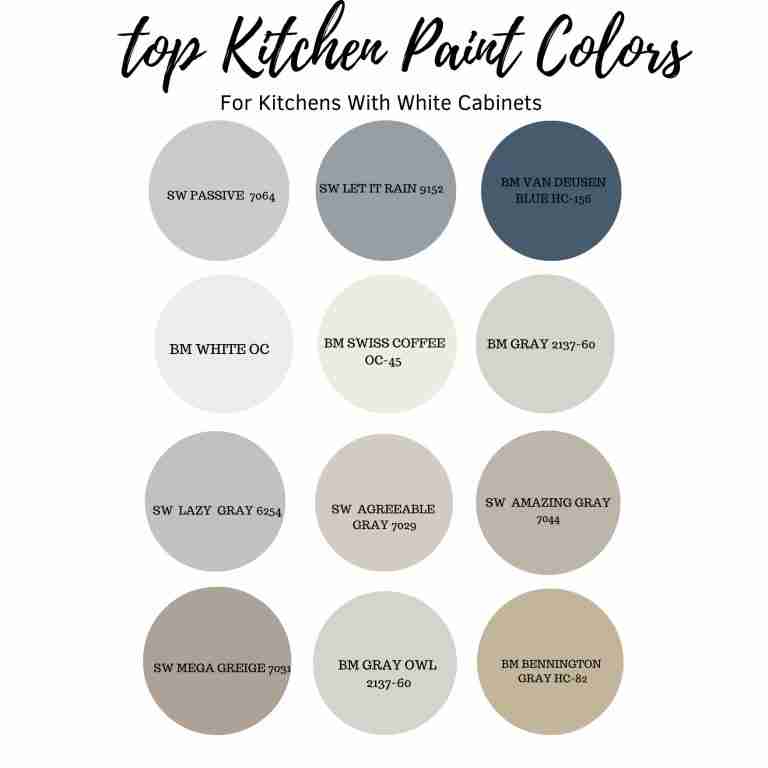The Tropical Monstera Deliciosa Indoor Plant Care Tips
Elevate your home decor with the vibrant energy and tranquility of a tropical Monstera Deliciosa plant. Discover the allure of this popular tranquil lush houseplant and delve into the art of caring for its distinctive beauty.
Explore why the Monstera plant has become a household favorite. Learn the secrets of cultivating and caring for this stunning addition to your indoor oasis.
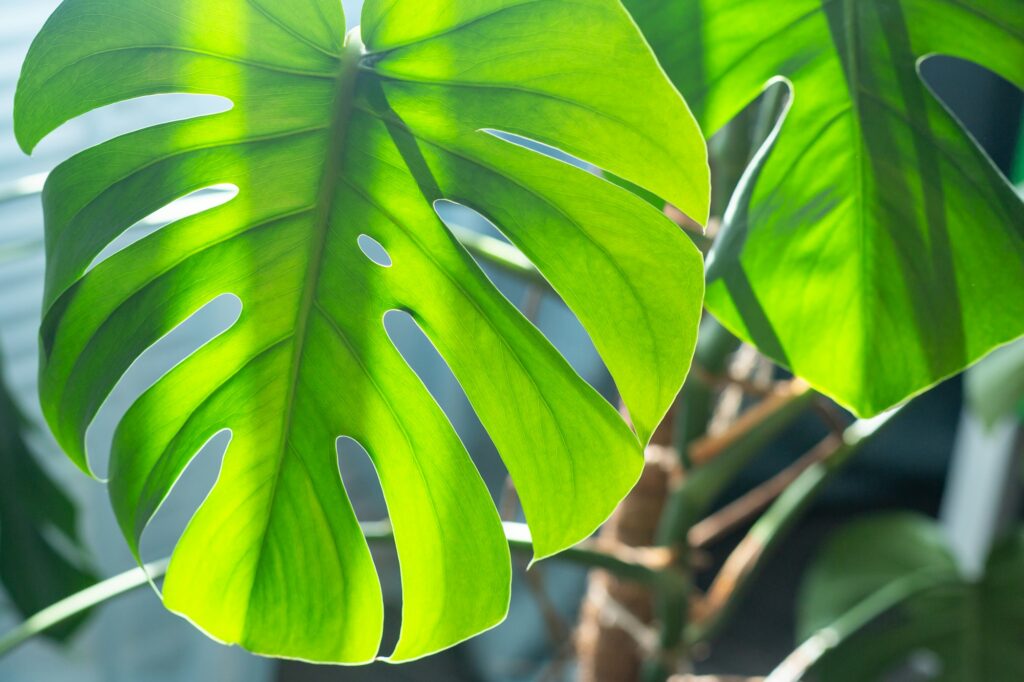
What is a Monstera Plant?
The Monstera deliciosa, widely recognized as the Swiss cheese plant or split-leaf philodendron, is a beautiful plant. Its tropical origins are the rainforests of southern Mexico, extending southward to Panama. It’s one the best houseplants for home decor.
In the wild, this vining plant is an evergreen liana, a climbing vine reaching over 70 feet. Its single, cylindrical stems, about 2½-3 inches thick, display a textured surface with leaf scars.
Renowned for its unique and distinctive foliage, this plant has gained popularity not only for its aesthetic tropical appeal but also for its hardiness and adaptability. It’s very easy to care for. No green thumb needed.
The “Swiss cheese plant” gets its nickname from the leaves, marked with unique holes resembling those in Swiss cheese. With large, glossy, and deeply lobed leaves, the Monstera deliciosa becomes a captivating presence in both indoor and outdoor settings.
The distinctive look of Monstera leaves brings an exotic touch of beauty to indoor spaces, contributing to its popularity as a decorative element in homes. The lush and tropical appearance adds a vibrant and eye-catching quality to any environment.

A Designer’s Hero For Home Decor
Monstera plant for its aesthetic appeal
Why Is The Monstera Plant So Popular?
Many designers and homeowners like to grow Monstera Plants because:
- Its ornamental value – As a species with an intriguing blend of beauty and adaptability, the split leaf philodendron continues to capture the attention of plant lovers and has become a staple in both tropical landscapes and interior decor worldwide. The Monstera Deliciosa is the ideal home decor piece.
- Easy Care- It’s an easygoing plant. No green thumb required.The Monstera deliciosa is also known for its resilience and ease of care. It thrives in a variety of environments, making it a favorite among plant enthusiasts.
- The tropical Vibe- beautiful Monstera plant brings that tropical vibe into any home.
- The Monstera Leaf is a designer superstar – You will see the leaf on wallpaper and other Single Monstera leaves are now prominently featured in the catalogs of Pottery Barn and Serena & Lily.
- Easy To Propagate
- Air Purification- According to NASA’s clean air study, plants with large, broad leaves (like monstera plants) can effectively remove certain toxins from the air.
- Feng Shui- Monstera plants grow rapidly upward and outward. In feng shui they represent expansion, upward growth, and positive energy.
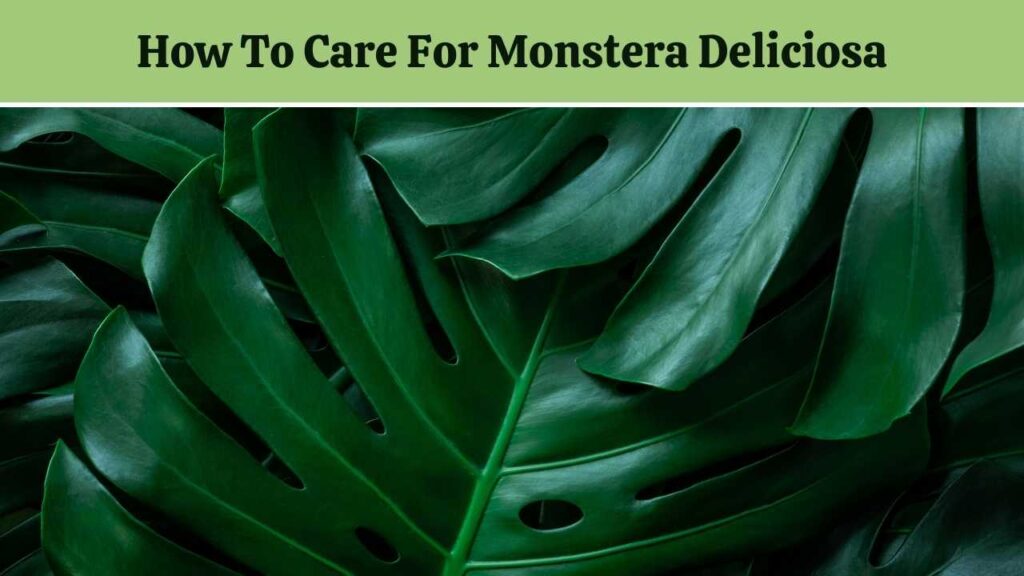
How To Care For A Tropical Monstera Split Leaf Philodendron
Monstera plant care is pretty simple. See the following plant care tips below
1. Sunlight
How Much Sunlight Does Your Monstera Need?
Throughout its active growth period (March to September), Monstera Deliciosa thrives when shielded from direct sunlight. Optimal placement involves bright, filtered light (indirect sunlight) or gentle shade.
The idea is to mimic the protection of a rainforest canopy by situating your plant near leaves from outdoor trees or behind a sheer curtain. Alternatively, position it in a well-lit room away from direct window exposure.
During the Winter months, your Swiss cheese plant will need more direct, bright light. This ensures the Monstera’s signature large, glossy leaves with well-defined divisions remain vibrant and attractive.
Regardless of where I put the chairs, the plants seem to enjoy the space. Plus, no direct sunlight means no burnt leaves–something to consider when finding the perfect spot for your monstera. It prefers bright indirect light.
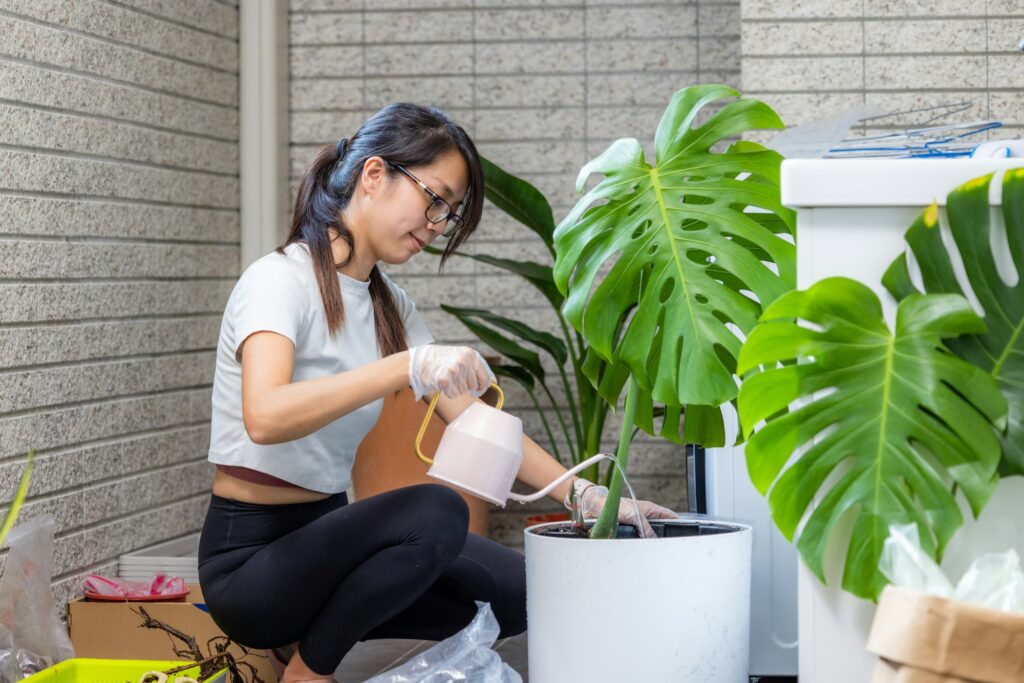
2. How To Pot A Monstera- Soil Tips
For indoor planting of your Monstera (Swiss Cheese Plant), it’s recommended to use a peat-based potting mix. This type of soil provides the right balance of nutrients, aeration, and moisture retention for optimal growth.
The plant requires a lot of space and a rich and loose soil (ideally garden soil and compost in equal parts). Monsteras like to be root-bound and can stay in the same pot for years, moving to one size larger pot only when the roots come out through the drain hole.
Additionally, ensure the pot has drainage holes to prevent water-logging and maintain well-drained conditions. This setup mimics the preferred environment of the “Swiss Cheese Plant”, fostering healthy development inside your home.
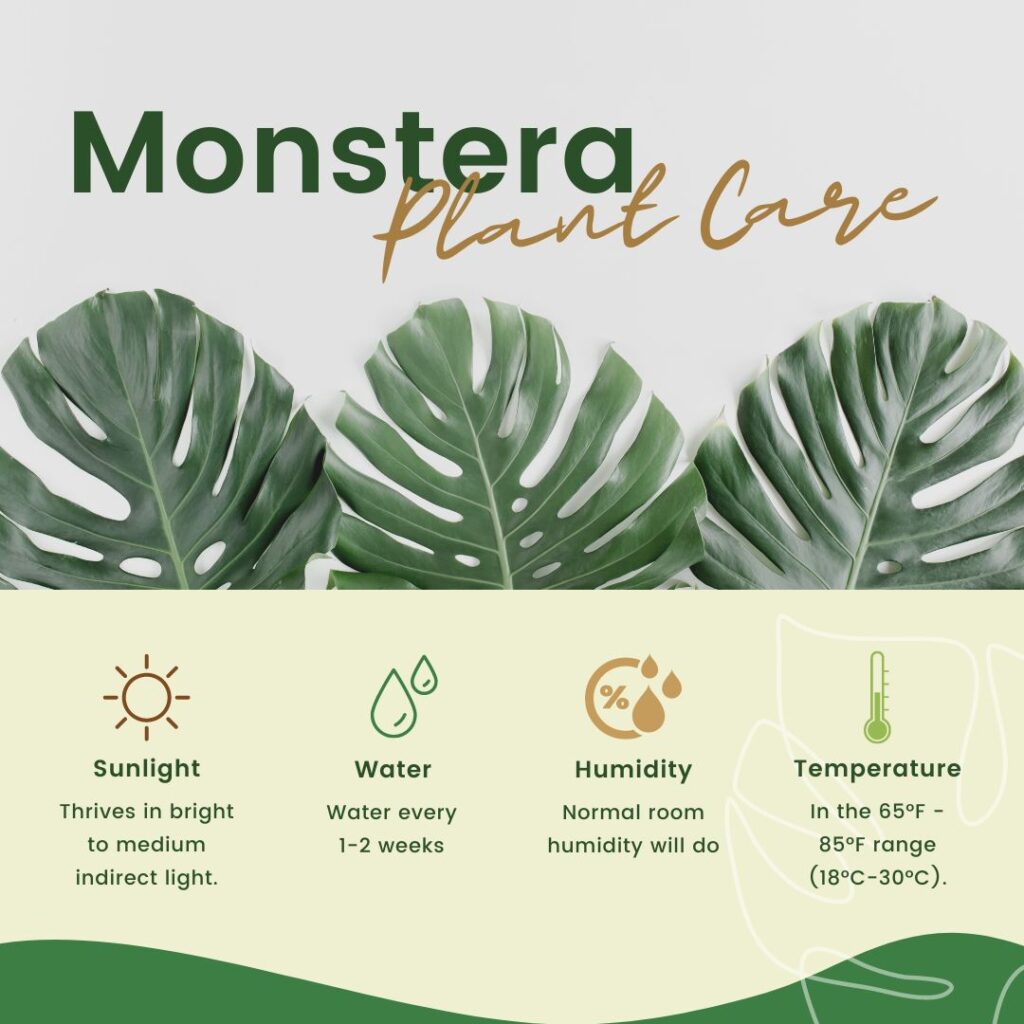
3. How To Fertilize A Monstera?
I give my Monstera Deliciosa some water fertilizer once a month during the growing season. Your split leaf philodendron deserves some special care!
Think of it like a personalized diet plan – it thrives best with a 3-1-2 N-P-K ratio. Picture it as a nutritional mix of three parts nitrogen, one part phosphorus, and two parts potassium.
These magical nutrients aren’t just for show–they’re like a healthy boost for your plant’s leaves, stems, and roots. And guess what? They’re the secret sauce behind those beautiful split leaves that make your Monstera so uniquely charming! Give your green friend the VIP treatment it deserves.

4. Humidity and Watering Tips
Do Monstera Deliciosa plants like humidity?
Yes, they do. Remember, they are tropical plants. In fact, monstera thrives in 40-60% humidity, akin to its tropical habitat.
While your home may not mimic a jungle, it’s crucial to check and regulate humidity levels. So how do you provide humidity for a monstera house plant?
In its natural tropical setting, split leaf philodendron enjoys warm temperatures and dappled sunlight, with some humidity. So spray (mist lightly) your plant lightly with water frequently. You can also place other plants nearby to add more moisture to the air.
I make sure to water the soil (with filtered water )thoroughly without making it too soggy. I check for moisture about 15 minutes later to remove any excess water from the drain. As the plants grow, I let the soil dry out a few inches between waterings.
I also like to mist the plants and their branches daily or add wet pebbles for that perfect humidity. It’s a bit of a routine–wringing out warm water each day and adjusting the water frequency during the summer.
Interesting fact, the Monstera leaf holes are a byproduct from originating in the dense rainforest. The holes allow sunlight to get to the bottom leaves as well as the top.
Temperature: Keep it Warm
“The Swiss cheese plant” prefers warm temperatures and stays happy above 50°F, especially during high temperatures and high humidity. Monstera thrives best in indirect light, in warm environments. Monstera will not survive in cold outdoor areas.
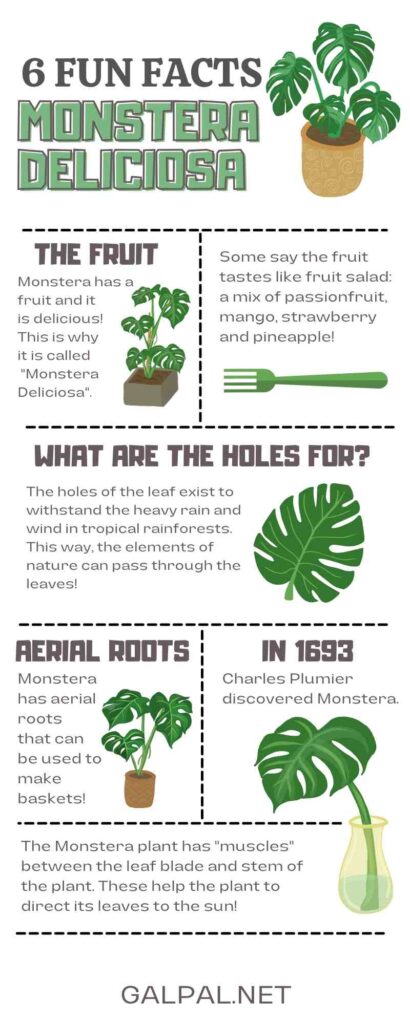
Common Problems With A Monstera Houseplant
A. Leaves turning brown and crispy at the edges:
Possible Causes: Thirsty plant, under-watered, or high salt build-up.
Remedy: Ensure regular watering, but avoid over-watering. Check for salt build-up by flushing the soil occasionally. Loss of the oldest leaves is natural and gradual.
B. Wilting plant, dry potting mix:
Possible Causes: under-watered or pot-bound (roots outgrowing the container).
Remedy: Water the plant adequately and consider repotting if it’s pot-bound to provide more space for root growth.
C. Yellowing leaves or black stems, wet potting mix:
Possible Causes: over-watering, leading to root rot. Remember, this Swiss Cheese plant’s natural habitat is tropical rainforests.
Remedy: Allow the soil to dry out between waterings, ensure proper drainage, and consider adjusting the watering frequency.

Various Monstera Plant Species
Originating from the rainforests of Central America, the Monstera genus boasts nearly 50 distinct species, including various cultivars and variegated varieties.
Those with variegated foliage or pronounced fenestrations (holes and splits) tend to be pricier due to their challenging propagation and slower growth. Let’s delve into some of the most common and closely related Monstera plants:
A. Monstera obliqua:
Among the rarest and most costly Monstera plants, Monstera obliqua stands out with its large, delicately formed holes and splits.
B. Monstera acacoyaguensis:
Distinguished by mature leaves that perforate instead of split, this variety offers a unique characteristic within the Monstera family.
C. Shingle plant (Monstera acuminata):
Displaying dark green, narrow leaves with small holes, the shingle plant is notable for its unique appearance. Additionally, Monstera acuminata is dark green, while Monstera adansonii is lighter.
D. Monstera adansonii (Swiss Cheese Plant):
Larger leaves, prominent holes, and a lighter green coloration set Monstera adansonii apart from M. acuminata, earning it the popular nickname of Swiss cheese plant. Monstera adansonii is distinguished from M. deliciosa by having longer, tapering leaves, as well as having completely enclosed leaf holes.
E. Monstera albo (Monstera deliciosa ‘Albo Borsigiana’):
This rare and expensive subspecies of Monstera deliciosa features stunning variegated coloring with white speckles.
Propagating A Monstera Deliciosa
Proper Propagation Of A Monstera With Stem Cuttings:
Use clean, sharp pruning shears to cut a stem containing a node (where roots will emerge), an aerial root, and at least two leaves.
Apply ground cinnamon to the cut on the mother plant to prevent disease and aid healing.
Place the cutting in a glass of water, changing the water every three to five days, preferably using filtered or rainwater.
In a few months, when roots have formed, transfer the new plant to a pot with fresh soil, ensuring it stays moist during the establishment phase.
Propagation with Air Layering:
- Select a stem with nodes or a leaf with a short aerial root.
- Make a small notch 1/3 of the stem’s width below the root.
- Wrap sphagnum moss around the point where the leaf meets the stem, then moisten it and cover with plastic, securing it with twist ties.
- Maintain moisture until roots develop in a few months.
- Once roots are established, use a clean, sharp tool to cut the stem below the roots and transplant the young plant into fresh soil.
- Apply ground cinnamon to the mother plant’s cut to prevent disease and aid healing.
- Both methods offer effective ways to propagate Monstera deliciosa, allowing you to expand your green family with healthy new plants.
Most Frequently Asked Questions:
Q: How fast does a Monstera grow?
Monstera can grow rapidly under optimal conditions, with new leaves emerging regularly during the growing season. The plant can get top heavy, so consider using plant ties.
Q. Can I keep my Monstera in a low-light environment?
The Swiss Cheese plant can tolerate lower light conditions but thrives best in bright, indirect light. Rotate the plant to ensure even growth.
Q. How do I support the growth of aerial roots?
Maintain higher humidity and provide occasional misting to encourage the development of aerial roots. Avoid removing them if possible.
Q. Is pruning necessary for Monstera plants?
Pruning helps maintain a bushy shape and control size. Trim back unwanted stems and leaves to promote healthier growth. n their native habitats, tropical plants typically climb trees, surpassing 70 feet in height.
As they ascend, older leaves shed, leaving bare stems. This can make container-grown plants top-heavy, with most leaves concentrated towards the vine ends.
If your plant is currently at a height you like, you can remove the growth at the top of each vine just above an existing leaf node. This will encourage growth from below the cut and lead to a fuller-looking plant.
WARNING: Monsteras contain calcium oxalate crystals in their tissues. These crystals help protect the plants from predators and can be irritating to skin. Wear gloves so you don’t get the sap in or around the eyes, mouth, or any other areas of the body.
Q. What kind of soil does a Monstera need?
Use a well-draining potting mix with organic matter. Peat-based mixes work well. Ensure good aeration for healthy root development.
Q. Should I mist my Monstera for humidity?
While Monstera prefers higher humidity, misting might not be sufficient. Consider placing the plant near a humidifier or on a tray with water.


